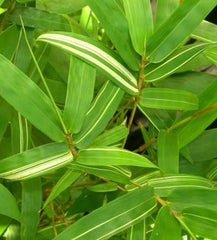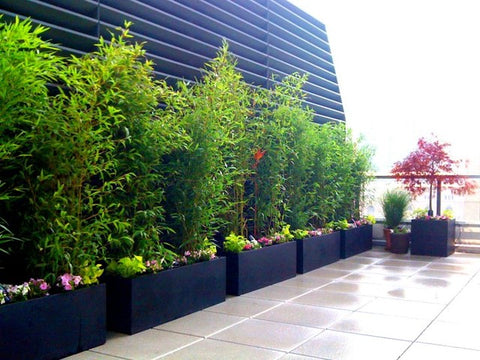How To Grow A Bamboo Privacy Screen In Containers
While you may love the idea of growing your own bamboo privacy screens, when it comes to a project such as this, space is your #1 concern. This is especially true for those who live in densely populated or suburban areas, and need to create their own privacy the most.
Growing a bamboo privacy screen in containers is not only a great idea for those who live in densely populated areas where limited space is an issue, but also for those who rent or lease their homes and don't want to make any permanent changes to the landscape. However, in order to produce the results you want, there are some important considerations to be made.

Choosing A Good Container Bamboo
While there are more than 100 varieties of bamboo plants, some are more suitable for container growing than others. It also stands to reason that if you are growing your privacy fence in containers, then you may wish to use a smaller variety of bamboo plants that won't grow too big to be moved at a later date.
When grown in containers, even the largest of bamboo varieties will not reach their full growth potential as their roots and rhizomes are constricted. However, some varieties have proven better for container growing than others.
Seabreeze
Also known as Bambusa Malingensis, Seabreeze Bamboo can reach a maximum height of 35 feet tall when planted in the ground with open space. Their culms only reach a 2 and a half inch diameter, and they can withstand temperatures down to 20 degrees F.
Seabreeze is one of the most salt tolerant bamboo plants that there is. They grow into tight clumps with fine grained wood. Seabreeze bamboo is considered one of the absolute best choices for a fast privacy screen or hedge due to its thick lateral foliage and upright growth.
When planted in a large, well-drained, and slightly insulated container, they can easily be maintained to stay at any height you choose with a once annual hedge trimming and just a few touchups throughout the year to remain at the height you want. They even make good standalone specimens, whether potted or not.
Multiplex Hedge Bamboo
Multiplex Hedge can reach maximum heights of 15 feet when planted in open spaces, however, when planted in containers, they are easily kept at more maintainable heights. There are a number of branches down the culm’s base on each node, and when grown in containers they have been known to reach 8 feet high. Cold tolerant down to 18 degrees, these little bamboo plants make a great choice for starting your own bamboo garden or growing a green screen.
Unlike most bamboo, Multiplex Hedge Bamboo is dark green and pencil-thin, which makes it the perfect candidate for potted containers or bonsai culture. As one of the hardiest choices out of the entire Bambusa genus, you can easily and quickly grow a 5 to 15 foot tall privacy screen or hedge with Multiplex.
Buddha Belly Bamboo
 Also known as Bambusa Ventricosa, this clump bamboo thrives in full sun to partial shade. With a maximum height that only reaches 20 feet tall, this bamboo is known for staying even smaller when kept in a container. While it is also popular as a small indoor plant or bonsai, it is highly versatile and adaptable to most conditions. With special attention and care, it can easily be restricted in a container. In addition, caretakers can artfully starve this bamboo for water in order to make it ‘belly out’.
Also known as Bambusa Ventricosa, this clump bamboo thrives in full sun to partial shade. With a maximum height that only reaches 20 feet tall, this bamboo is known for staying even smaller when kept in a container. While it is also popular as a small indoor plant or bonsai, it is highly versatile and adaptable to most conditions. With special attention and care, it can easily be restricted in a container. In addition, caretakers can artfully starve this bamboo for water in order to make it ‘belly out’.
Buddha Belly Bamboo can adapt to nearly any lighting conditions and can withstand temperatures as low as 15 degrees Fahrenheit. This bamboo is known for requiring more water than most other types of bamboo, but it is one of the absolute best choices for indoor and outdoor container growing.
These are only 2 examples of bamboo plant varieties that are excellent for growing a bamboo privacy screen in containers. For even more ideas, check out our Best Indoor/ Outdoor Bamboo for Pots Collection.
Finding The Perfect Containers
After you have chosen the perfect potted bamboo plant, the next step is to ensure that you have an appropriate container for your new plant.
It is important to remember that bamboo plants grown in containers are not nearly as hearty as those grown in the ground. Although they are still very hardy. They require more care as well, since they have to be divided or repotted every 2 to 5 years. Environmental stress affects potted bamboo more than in-ground bamboo plants as well. However, by ensuring that their needs are met, you can have a thriving bamboo tree nearly anywhere, whether indoors or not.
For starters, the constricted root space makes it easy for them to dry out, and they are also more affected by cold, heat and strong winds. However, when their needs are met, bamboo plants will grow and thrive in the right containers. You can use metal feed troughs, but you should make sure they have enough drainage, insulation and hardy plants.
Ideally, large wooden containers can make a great home for bamboo plants, and provide some additional insulation as well. Regardless of what type of container you choose, as long as it provides enough space, drainage and insulation, your potted bamboo should thrive.
Putting Your Potted Bamboo Hedge Or Screen Together
After determining what type of bamboo and containers to use, you simply begin putting it all together. Just as an in-ground bamboo screen or hedge must be spaced appropriately, you must also determine how far to space your container bamboos.
For most, a good rule of thumb is to follow the guidelines for in-ground spacing. However, due to the fact that bamboo in containers does not grow as large as potted bamboo, you may wish to take the in-ground spacing guidelines for your bamboo and divide them by half. So, bamboo that should be planted 6 feet apart in the ground would only require about 3-4 foot spacing.

Maintenance
Maintaining a potted bamboo hedge or screen actually requires very little work once the plants have initially been set up. By providing a yearly, slow-release, high nitrogen fertilizer, you can ensure that your bamboo plants are receiving a steady diet of nutrients. In addition, for at least the first year, you should irrigate or ensure that your bamboo plants are receiving plenty of water. After about 3-4 years, you should take each bamboo plant and divide them, in order to ensure that they have ample room to grow.
Potted bamboo hedges and screens are a great choice for those who have tight spaces or simply would prefer not to make any permanent changes to the landscape.
Get A Free Consultation For Your Bamboo Project Today! Call 888-784-7336
photo credit: BAMBOOLICIOUS via photopin (license)


